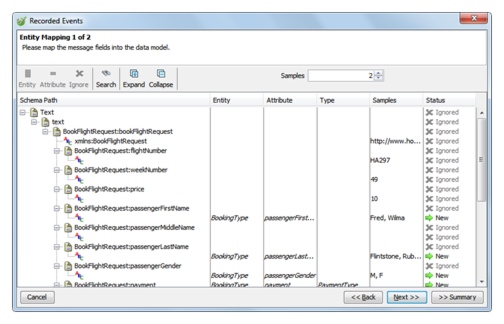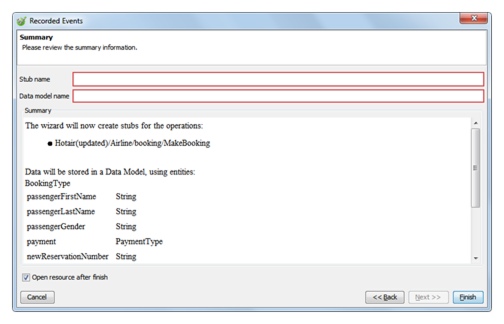Basic (hard-coded) and parameterized (data-driven) stubs
are examples of simple stub-types because the data that is provided
when the stub is run is either hard-coded in the stub itself or is
taken from a simple data source (whichever is applicable).
About this task
In each case, the same data is used each
time when the stub is started.
However, the testing
of complex systems may require persistent storage of data so that
a stub can save information across multiple operations. This enables
you to virtualize services that create data, for example, a customer,
and then use that data in a "GetCustomer" service without having to
know a design time the data will be used. It is this capability that
distinguishes simple stubs from those that are coordinated to provide
a virtualized application.
In cases where you
require multiple operations within a stub, or multiple stubs to share
data to provide a virtualized application, you should use a data model
to hold such data. Data models can be shared across stubs. In addition,
data models can hold data about multiple entities and their relationships,
such as customers and orders.
Therefore, a data
model is a simple view of entities and their relationships that can
be used by stubs to persist information. Data models exist as assets
within a project. A stub’s properties define which data model it is
using (if any). Stubs can read and modify data held in a data model.
The Stub Editor (for information about this, refer to Modifying message-based stubs) enables you
to indicate whether an operation is trying to create, update, or delete
data based on the received message, reducing the time and effort required
to create rich stubs.
In IBM Rational Integration Tester,
you can create a data model by using the Data Model Editor (for information
about this, refer to Using the data model editor). Alternatively, you can create a data model
while creating a data model-driven stub from recorded events. This
second method analyzes the message in recorded events and creates
a data model and entities within that data model based on the messages.
Operations that are created will connected to the data model automatically.
To create a data model-driven stub from recorded events:
- In Rational Integration Tester’s
Recording Studio perspective, select multiple recorded events on the
Events View window.
Note: For
information about using the Events View window, including searching
recorded events, see
Managing the Events view.
- Click the arrow button
(
 ) next to the Save Stub from selected events button
(
) next to the Save Stub from selected events button
( ) on the Events View toolbar and then click Save
Data Model Stub on the shortcut menu.
) on the Events View toolbar and then click Save
Data Model Stub on the shortcut menu. Alternatively, right-click the messages and click Save
Data Model Stub on the shortcut menu.
The
Operation Assignment screen of the Recorded Events wizard is displayed.
The Operation Assignment screen, which is the third
screen of the wizard, enables you to modify (if you want) the operation
and the events associated with the stub.
Note: The
first and second screens of the Recorded Events wizard are the Resource
Type and Data Storage screens. The screens are displayed only if you
click the
Save button (

) or press
CTRL+S. Clicking the
Save Stub from selected events button
(

) bypasses the Resource Type and Data Storage screens.
For information about using Operation Assignment screen,
refer to Creating basic stubs.
Note: If you are creating a stub for multiple operations, Rational Integration Tester will
attempt to verity that all selected recorded events are associated
with the correct operations.
- Clicking Next on
the Operation Assignment screen displays the Transaction Assignment
screen.
The Transaction Assignment screen,
which is the fourth screen of the Recorded Events, enables you to
group events into transactions.
Note: The groups
that you choose are important because they will determine the number
of merged messages and thus the number of remaining screens in the
Recorded Events wizard. For example, one recorded event may have a
single transaction, which means that there is only one mapping. Alternatively,
two recorded events may be grouped into two groups, which means that
there are two transactions and thus only one mapping. Equally, two
recorded events may be put into a single group, which means that there
are two mappings.
For information about using
Transaction Assignment screen, refer to Creating basic stubs.
- Clicking Next on
the Transaction Assignment screen displays the Entity Mapping screen.
The Entity
Mapping screen enables you to map the fields in the selected recorded
events to the data source that will be used for data model-driven
stubbing.
The following table describes how
to use the Entity Mapping screen.
| To... |
Do this... |
|---|
| Specify that a field in a recorded event will be an entity
in the data model |
1. Select the field. 2. Click Entity.
The Map to entity dialog box is displayed.
3.
Click OK. For the selected field, New is
displayed under Status.
|
| Specify that a field in a recorded event will be an attribute
of a particular entity in the data model |
1. Select the field. 2. Click Attribute.
The Map to Attribute dialog box is displayed.
3.
Click OK. For the selected field, New is
displayed under Status.
|
| Specify that a field in a recorded event is not included in
the data model |
1. Select the field. 2. Click Ignore.
|
| Search for a specific data item in a recorded event |
1. Click Search. 2.
In the Find field (displayed on the lower half of the screen),
enter your search query.
3. Press ENTER.
|
| Increase or decrease the number of example values displayed
for each field |
In the Samples box, enter or select the number of examples
you want to display (default value: 2). |
| Specify that a field is a "key" field so that it can be used
to match data between different messages |
Under the Key column, select the check box of the field. |
| Expand or collapse a node |
1. Click the node. 2. Click Expand or Collapse (as
applicable).
|
| Close the wizard without making any changes |
Click Cancel. |
| Move to the (previous) Transaction Assignment screen |
Click Back. |
| Move to the next screen |
Click Next. Note: The
next screen may be another Entity Mapping screen because the number
of Entity Mapping screens displayed by the Recorded Events wizard
depends on the number of merged messages (which determined by the
using the Transaction Assignment screen).
|
| Move to the (final) Summary screen of the wizard |
Click Summary. |
The Summary screen, which is the final
screen of the Recorded Events wizard, enables you to review the configuration
of the stub and to save the stub and the data model.
For information about
using the Summary screen, refer to Creating basic stubs.

